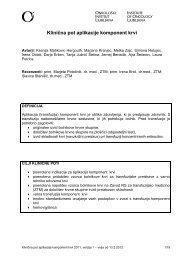You also want an ePaper? Increase the reach of your titles
YUMPU automatically turns print PDFs into web optimized ePapers that Google loves.
Effect of immunomodulator biological response modifiers<br />
on murine tumors and metastases<br />
T. A. Korolenko 1 , T. V. Alexeenko 1 , S. Ya. Zhanaeva 1 , A. A. Venediktova, G. Kogan 2 ,<br />
N. N. Besednova 3 , T. A. Kuznetzova 3 , T. N. Zviagintzeva 3 , V. I. Kaledin 4<br />
1<br />
Institute of Physiology RAMS, Novosibirsk, 630099, Russia; 2 Institute of Chemistry, Slovak<br />
Academy of Sciences, Bratislava, Slovakia; 3 Institute of Epidemiology and Microbiology RAMS,<br />
Vladivostok, 690087, Russia; 4 Institute of Cytology and Genetics RAS, Novosibirsk, 630090, Russia<br />
Increased expression, activity and secretion of cysteine, aspartic, metallo- and serine<br />
proteases by tumor cells was shown to connect with tumor growth, invasion and<br />
metastases formation. Biological response modifiers, increasing the host resistance<br />
mechanisms, are perspective in tumor treatment and prevention. The aim: to<br />
study effect of macrophage (Mph) stimulators with different terminal groups and<br />
interaction with Mph glucan or/and fucose receptors in antitumor treatment using<br />
cysteine proteases and their endogenous inhibitor cystatin C as possible markers<br />
of prognosis and efficacy of antitumor therapy. Water-soluble chemically modified<br />
β-1,3-glucans (Institute of Chemistry, Slovak Academy of Sciences, Bratislava) and<br />
polysaccharide fucoidan (Institute of Epidemiology and Microbiology RAMS, Vladivostok,<br />
Russia) have been used. Cathepsins B, L activity and cystatin C concentration (KRKA,<br />
Slovenia) were determined as described (Khalikova et al., 2005). β-1,3-glucans were<br />
shown to increase the positive therapeutic effect of cyclophosphamide (CPA), but did<br />
not reveal antitumor activity themselves (without CPA). Murine tumors (HA-1 hepatoma,<br />
lymphosarcoma LS, Lewis lung carcinoma) were characterized by drastically decreased<br />
cystatin C concentration in tumor cells with significant restoration of cystatin C level in<br />
tumor cells and serum after effective antitumor therapy by CPA or/and β-1,3-glucans.<br />
Cystatin C concentration in tumor tissue and serum can be used as an index of<br />
prognosis of tumor development and efficacy of antitumor therapy. β-1,3-D-glucans are<br />
internalized after binding to specific β-glucan (also to scavenger and dectin) receptors<br />
on Mph and reduced internalization can be responsible for down regulation of<br />
Il-11 and TNF-β secretion (and apoptosis). Fucoidan (alone) was shown to<br />
suppress significantly tumor growth rate and metastases into lung in mice<br />
with Lewis lung carcinoma and did not influence in combination with CPA<br />
(10-100 mg/kg). The most effective was scheme with isolated repeated administration<br />
of small dose of fucoidan (5 mg/kg, 3 times). Fucoidan (5 and 10 mg/kg) decreased<br />
cathepsin L activity (three times) in tumor tissue, but did not change cathepsin B<br />
and D activity, as compare to untreated tumor. Similar results (except cathepsin D)<br />
were obtained in mice treated by combination of CPA + fucoidan. One can conclude<br />
that polysaccharide fucoidan in small repeated doses revealed strong antitumor and<br />
antimetastatic activity acting, possibly, directly on tumor cells and monitoring of tumor<br />
cysteine proteases is useful in control of the efficacy of therapy.<br />
88p17<br />
Supported by INTAS grant <strong>02</strong>-0592 and Innovation Grant of Siberian Branch of RAMS,<br />
2005-2006.<br />
References: Khalikova T.A., Zhanaeva S.Ya., Korolenko T.A. et al. Cancer Letters, 223<br />
(2005) 77-83

















